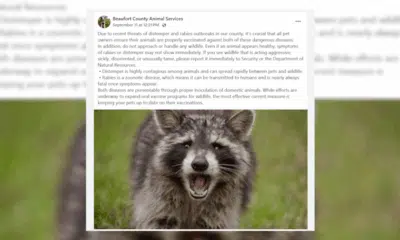News from the South - North Carolina News Feed
Helene’s floodwaters have abated, but the risk of more potentially deadly landslides persists in the region, scientists say • Asheville Watchdog
Dozens of powerful, fast-moving landslides carved deep scars into the hills and valleys around Buncombe County amid the fury of Tropical Storm Helene, sweeping away lives, destroying or damaging buildings and roadways, and dumping vast amounts of soil, rocks, and organic matter into rivers and reservoirs.
While record flooding caused much of Helene’s devastation last month, geologists have mapped at least 301 landslides in Buncombe as of Oct. 24 — and more continue to be reported in steeply sloped terrain made unstable by torrential rainfall before and during the storm’s assault.
“I’ve had the opportunity to work a number of landslide disasters of this scale and I’ll say that in terms of the impact to community, this is one of the worst in U.S. history,” said Jonathan Godt, Program Coordinator for Landslide Hazards with the United States Geological Survey (USGS) at a Buncombe County briefing Oct 18.
“We have observed, now, over 1,000 landslides” in the storm-ravaged region of southern Appalachia, “and we’re mapping more and more every day,” said Paula Burgi, a research geophysicist with the USGS.
“There’s an elevated landslide hazard now that there’s been so much destabilization” of both underlying soil and of material displaced by earlier landslides, Burgi told Asheville Watchdog. The unstable material has “the potential to fail more, to continue to move downslope, or for more material near the top of the landslide to [fall],” she said.

“It just sucks because everyone here has gone through such a horrible, traumatic time, but unfortunately, the hazard isn’t over now that the hurricane is over,” Burgi said.
Godt said the USGS has not identified any large, major landslide movement that could occur in the coming weeks or months that would impact recovery activities. But he also warned that the recent landslides can become active again if the region once again experiences prolonged heavy rain.
Types of landslides
Of the 301 landslides mapped in Buncombe County so far by the USGS, 163 damaged roads, rivers, and structures — including 30 slides along the Blue Ridge Parkway in North Carolina, 10 of which were called “catastrophic.”
A spokeswoman for the National Park Service declined to offer estimates on when the Parkway might fully reopen, but said some of the slide damage could take “years” to repair.

One hundred and thirty-two of the Buncombe slides have been classified as “debris flow,” a fast-moving, unstoppable, highly destructive, and potentially deadly type of landslide comprising soil, mud, rocks, and trees.
Debris-flow slides — often called mudslides — sent tons of mountainside hurtling down on houses and trailers even as floodwaters threatened from below. Death certificates reviewed by Asheville Watchdog cite landslides as causing or contributing to at least 13 of Buncombe County’s 42 Helene-related deaths — including a landslide that took 11 members of one family in the Garren Creek community of Fairview. Pieces of their houses and belongings were strewn across a debris field more than a mile long.
Witnessing a catastrophic debris flow: ‘It was just like a roaring train’
Alicia Craig witnessed this debris flow firsthand. The home she shares with her husband, Kevin, and their two children, narrowly missed becoming part of the flow, only because a large downed tree smashed into their garage and the rootball got lodged against the house, creating a sort of diversion dam around the home.

Still shaken by the horror she witnessed the morning of Sept. 27, Craig said one odd feature of the slide remains seared into her consciousness: the smell.
“It was very dirty — propane and kind of just a mud smell that you just can’t get out of your nose,” Craig said, standing in her backyard, just feet from where the normally placid “Craig Branch” turned into a raging river that spawned the landslide.
The debris flow obliterated houses and sheds and thousands of trees, crumpling cars and pickup trucks like balled up sheets of paper. It hit the holler, often called “Craigtown” because so many family members lived there, in at least three distinct waves. It killed 11 members of the Craig family.
“I opened my door and I heard a sound, a roaring sound,” Craig said. “And then that’s when I saw the house above us come toward my house. It was just like a train, like a roaring train.”
The slide started about 1.5 miles up the mountain from the Craigs’ homes.
A formula for disaster
Philip Prince, a geologist and adjunct professor at Virginia Tech University, has been studying Helene’s effects in western North Carolina, and he produced a 28-minute video on the Garren Creek slide that has garnered more than 434,000 views. The area affected sits in a sloping area near the intersection of Flat Creek Road and Old Fort Road, not far from the local fire department building.
Prince said the debris flow spans nearly two miles from top to bottom. It was “big by Appalachian scales,” he said, and very likely comprised multiple sequential slides, or “pulses.”
One of the reasons this slide was so devastating is because of the Swannanoa Mountains that rise up near the back of the cove, or what the Craigs call the holler. This part of the Appalachian mountain chain has more complex topography than the “Appalachian valley and ridge” type of mountains in other areas, and that’s mainly because of the bedrock, which is metamorphic rock, Prince said.

Our mountains here have a more “branching topographic pattern,” meaning stream networks come off the sides of the steep topography and may have several small branches that come together, producing larger streams, according to Prince. These origin streams can be very small, even by the time they reach the valley floor.
“And the issue there is that they look so small, it’s hard to imagine a small stream like that having the potential to do much damage, really, under any circumstance,” Prince said.
The lives we lost: Fairview landslides from Helene that killed 13 were among worst in North Carolina history
Craig family members said the stream in the middle of their property was so small you could jump over it, and it didn’t even have an official name, although they called it “Craig branch.” After Helene, it was 35 feet across in places, and it scoured out underlying soil and rock 20 feet down.
Excessive rainfall created that raging river. An “orographic lift” — an upsloping motion that causes a storm to rise as it hits the mountains, then creating a sort of conveyor belt of rain into the area — caused so much water in a short period of time to hit the steep slopes.
It was a formula for disaster, Prince said. He estimates that about 1 million cubic feet of material mobilized for the main track of the longest debris flow — the one that hit Craigtown.
Tiny streams, destructive debris flows
As he puts it in the video about the Garren Creek slide, “even a tiny, tiny, tiny little stream or branch actually has more potential to produce a destructive debris flow than a large stream does, because that tiny stream is coming off of a very, very steep slope.”
In this case, multiple smaller slides from the branching streams ultimately converged into the same path, leading to Craigtown. On the high mountainsides where these slides started, the bowl-shaped areas have about 25 to 30 degrees of slope.
That would translate to a 46 percent grade. For comparison, Interstate 40 at Old Fort Mountain has a 6 percent grade.
The ground in these high areas is called colluvium. It’s a combination of “chunks of rock that fall off cliffs and kind of pile up,” and soil, Prince said. Combined with copious amounts of rainfall, this loose material will start to slide.
Like a snowball gathering more and more snow as it rolls downhill, debris flows typically start off very small, and often come from multiple branches in the creases of the mountains. They originate in extremely steep areas in very unstable, saturated ground — sometimes just two feet thick and maybe 40 or 50 feet wide.
“It would not look that significant where it began, but it’s going to make its way down this channel and pick up everything along the way,” Prince said. “And if you are in its path, it’s really not something that can be blocked or stopped by a structure. The amount of mass involved, it’s just sort of on the next level.”
‘It’s the F5 tornado of the Appalachians’
In Craigtown, the evidence of that is overwhelming. The slide compacted cars and trucks, twisted steel I-beams from mobile homes like they were pipe cleaners and tossed broken trees about the landscape like twigs.
Prince estimates the affected area is about 450 feet wide, the deeply scoured areas about 100 feet across.

He notes that the speed of these flows is also mind-boggling. In the video, Prince outlines one part of the Garren Creek slide that’s about a mile long.
“If it’s going 30 miles an hour, you’re going to have about two minutes,” Prince said. “So, it’s not a situation in which it’s practical to warn people that may be assisting that another one’s coming.”
Two of the fatalities in Garren Creek were a firefighter and his nephew who rescued one survivor and were headed to another after one slide, only to be swept away in another.
These kinds of mega-slides are just “a grinder of boulders and trees.
It’s the F5 tornado of the Appalachians,” Prince said. “The maximum destructive event of this part of the world.”
Prince noted that the Craigtown area likely was built on the remains of some long-ago slide that deposited material at the base of the mountains, providing a relatively level, and beautiful, place to build homes centuries later. The Appalachians in our part of the world “are massively scarred with the landslides that were produced by storms comparable to Helene” in the past, he said.
But people tend to settle in relatively flatter areas, with access to streams and creeks, like Craigtown.

“Typically, you see a development pattern here with houses sort of lining these small streams and sort of spreading out basically anywhere in this landscape that you can get a good, flat place to live,” Prince said. “It’s a nice place to be, right? And if you’re not here for 1,000 years or something like that, perhaps you’ve never seen an event like this before.”
Her arms crossed as she gazes out over the destruction next to her home, Alicia Craig said she and her husband have lived in Craigtown for 20 years, two in their current home.
“You don’t ever imagine this would happen to your family, because we were so close, literally,” she said. “I mean, we were so close living (nearby), but we were together. We were a close family. Very tight knit. We had family dinners almost every night.”
‘We were primed to have these mudslides’
Seventy-five additional landslides in Buncombe were classified as shallow, a type that is typically slower-moving and that results from prolonged heavy rain. Unlike debris-flow slides that often happen without warning and travel downslope as fast as 30 mph, shallow slides often have precursors that give people a better chance of evacuating.

In addition to the hundreds of roads in western North Carolina that were washed away by flooding, hundreds more were buried or obstructed by slides, including Interstate 40 east of Asheville near Old Fort. The road closures made it difficult if not impossible for several days for geologists to make accurate landslide maps to give to first responders.
But using an array of observation tools including small aircraft, drones, satellite imaging, and when possible researchers on foot, state and national geologists now have a better picture of the damage from Helene’s landslides.
Burgi, the research geophysicist, is part of the Landslide Assessment Situational Awareness and Event Response Research (LASER) team at the USGS that is activated when requested by the federal or state government. The team was requested to assist the North Carolina and Tennessee Geological Surveys to provide technical assistance with remote mapping of the landslides.
Burgi said the team is now on the lookout for “natural dams,” rivers that are blocked by landslides. The team hasn’t seen any of these in western North Carolina, she said, but “that is the worry.”
“Natural dams can be very unstable, and when the water overtops or breaks through that natural dam, it can cause catastrophic flooding downstream,” Burgi said. “And if there are people downstream, that is a problem.”
Speaking in Asheville at the county briefing Oct. 18, David Korte, senior geologist with North Carolina Geological Survey (NCGS), noted that three factors determine the ferocity of landslides: the steepness of the hill, the amount of water available, and its path, which in the case of the lethal Fairview slide, was down a stream channel.
In western North Carolina it takes five or more inches of rain within 24 hours to potentially trigger a landslide, Korte explained. “What Helene did to us was over five inches every 24 hours for almost four days,” he said. “So we were primed to have these landslides.”

But field investigators from the North Carolina Geological Survey and UNC Asheville’s National Environmental Modeling and Analysis Center (NEMAC) also found that lesser amounts of rain can trigger a debris flow on slopes that have been modified by humans.
Korte recommended that residents, especially those near landslide sites, should “keep an eye on the weather report” and evacuate ahead of the likelihood of prolonged heavy rainfall.
Was some landslide damage preventable?
While much of the tens of billions of dollars in damage left behind by Helene is directly attributable to nature, experts say some of it may have been preventable.
The NCGS and NEMAC researchers found that many landslides and debris flows have occurred on slopes in western North Carolina that have been modified by human activity — road and home construction, altered irrigation patterns, removal of vegetation, and the like.

Western North Carolina has long been known to be at particular risk for landslides and mudslides because of its steep slopes; USGS maps of historical landslides show Asheville approximately at the center of the region’s high-risk zone. “Landslides and debris flows usually happen in areas where they’ve occurred before,” NCGS researchers wrote.
But stabilizing vulnerable areas geologically is often prohibitively expensive, and many other factors conspire to put more humans in harm’s way:
- Climate change: As Earth’s oceans and atmosphere warm as a result of human-caused climate change, storms are more frequent, more intense, and more damaging. “Our best estimate is that climate change may have caused as much as 50% more rainfall during Hurricane Helene in some parts of Georgia and the Carolinas,” scientists at the Lawrence Berkeley National Laboratory concluded after running thousands of simulations. “Furthermore, we estimate that the observed rainfall was made up to 20 times more likely in these areas because of global warming.” In other words, when it rains, it pours.
- Inadequate building codes: “Over the past 15 years, North Carolina lawmakers have rejected limits on construction on steep slopes, which might have reduced the number of homes lost to landslides,” The New York Times reported, citing the influence of lobbying by the North Carolina Home Builders Association. The General Assembly has also “blocked a rule requiring homes to be elevated above the height of an expected flood; weakened protections for wetlands, increasing the risk of dangerous storm water runoff; and slowed the adoption of updated building codes, making it harder for the state to qualify for federal climate-resilience grants,” The Times reported.
“The General Assembly’s legislation that stops the update of building codes makes North Carolina less competitive for federal funds to strengthen the response of communities across the state to natural disasters like Hurricane Helene,” wrote Jordan Monaghan, a spokesperson for Gov. Roy Cooper. “Over the next few months as the General Assembly works to pass legislation to help with Hurricane Helene recovery, they should consider changing this law.”
On Thursday, Cooper’s office estimated the total damage from Helene in North Carolina to be $53 billion.
Asheville Watchdog is a nonprofit news team producing stories that matter to Asheville and Buncombe County. Investigative reporter Victoria A. Ifatusin joined us through a 12-month fellowship as part of the Scripps Howard Fund’s Roy W. Howard Fellowship program. You can reach her via email at vifatusin@avlwatchdog.org. John Boyle has been covering Asheville and surrounding communities since the 20th century. You can reach him at (828) 337-0941, or via email at jboyle@avlwatchdog.org. Peter H. Lewis is The Watchdog’s executive editor and a former senior writer and editor at The New York Times. Contact him at plewis@avlwatchdog.org. To show your support for this vital public service go to avlwatchdog.org/support-our-publication/.
Related
The post Helene’s floodwaters have abated, but the risk of more potentially deadly landslides persists in the region, scientists say • Asheville Watchdog appeared first on avlwatchdog.org
News from the South - North Carolina News Feed
White House officials hold prayer vigil for Charlie Kirk
SUMMARY: Republican lawmakers, conservative leaders, and Trump administration officials held a prayer vigil and memorial at the Kennedy Center honoring slain activist Charlie Kirk, founder of Turning Point USA. Kirk was killed in Utah, where memorials continue at Utah Valley University and Turning Point USA’s headquarters. Police say 22-year-old Tyler Robinson turned himself in but has not confessed or cooperated. Robinson’s roommate, his boyfriend who is transitioning, is cooperating with authorities. Investigators are examining messages Robinson allegedly sent on Discord joking about the shooting. Robinson faces charges including aggravated murder, obstruction of justice, and felony firearm discharge.
White House officials and Republican lawmakers gathered at the Kennedy Center at 6 p.m. to hold a prayer vigil in remembrance of conservative activist Charlie Kirk.
https://abc11.com/us-world/
Download: https://abc11.com/apps/
Like us on Facebook: https://www.facebook.com/ABC11/
Instagram: https://www.instagram.com/abc11_wtvd/
Threads: https://www.threads.net/@abc11_wtvd
TIKTOK: https://www.tiktok.com/@abc11_eyewitnessnews
News from the South - North Carolina News Feed
Family, friends hold candlelight vigil in honor of Giovanni Pelletier
SUMMARY: Family and friends held a candlelight vigil in Apex to honor Giovanni Pelletier, a Fuquay Varina High School graduate whose body was found last month in a Florida retention pond. Giovanni went missing while visiting family, after reportedly acting erratically and leaving his cousins’ car. Loved ones remembered his infectious smile, laughter, and loyal friendship, expressing how deeply he impacted their lives. His mother shared the family’s ongoing grief and search for answers as authorities continue investigating his death. Despite the sadness, the community’s support has provided comfort. A celebration of life mass is planned in Apex to further commemorate Giovanni’s memory.
“It’s good to know how loved someone is in their community.”
More: https://abc11.com/post/giovanni-pelletier-family-friends-hold-candlelight-vigil-honor-wake-teen-found-dead-florida/17811995/
Download: https://abc11.com/apps/
Like us on Facebook: https://www.facebook.com/ABC11/
Instagram: https://www.instagram.com/abc11_wtvd/
Threads: https://www.threads.net/@abc11_wtvd
TIKTOK: https://www.tiktok.com/@abc11_eyewitnessnews
News from the South - North Carolina News Feed
NC Courage wins 2-1 against Angel City FC
SUMMARY: The North Carolina Courage defeated Angel City FC 2-1 in Cary, ending their unbeaten streak. Monaca scored early at the 6th minute, followed by Bull City native Brianna Pinto’s goal at the 18th minute, securing a 2-0 halftime lead. Angel City intensified in the second half, scoring in the 88th minute, but the Courage held firm defensively to claim victory. Pinto expressed pride in the win, emphasizing the team’s unity and playoff ambitions. Nearly 8,000 fans attended. Coverage continues tonight at 11, alongside college football updates, including the Tar Heels vs. Richmond game live from Chapel Hill.
Saturday’s win was crucial for the Courage as the regular season starts to wind down.
https://abc11.com/post/north-carolina-courage-wins-2-1-angel-city-fc/17810234/
Download: https://abc11.com/apps/
Like us on Facebook: https://www.facebook.com/ABC11/
Instagram: https://www.instagram.com/abc11_wtvd/
Threads: https://www.threads.net/@abc11_wtvd
TIKTOK: https://www.tiktok.com/@abc11_eyewitnessnews
-
News from the South - North Carolina News Feed6 days ago
What we know about Charlie Kirk shooting suspect, how he was caught
-
Local News7 days ago
Russian drone incursion in Poland prompts NATO leaders to take stock of bigger threats
-
Local News Video7 days ago
Introducing our WXXV Student Athlete of the Week, St. Patrick’s Parker Talley!
-
News from the South - North Carolina News Feed6 days ago
Federal hate crime charge sought in Charlotte stabbing | North Carolina
-
The Center Square7 days ago
Weapon recovered as manhunt continues in Kirk assassination investigation | National
-
Our Mississippi Home5 days ago
Screech Owls – Small but Cute
-
News from the South - Tennessee News Feed7 days ago
Middle Tennessee State University dean filed over Kirk comments | Tennessee
-
News from the South - Arkansas News Feed6 days ago
NW Arkansas Championship expected to bring money to Rogers
















































